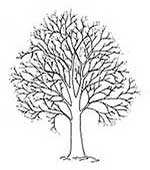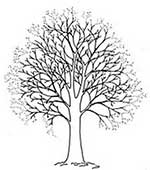You can apply for permission to work on protected trees using the Planning Portal.
Apply for permission for tree works
You can also apply by complying and returning the application form us to us by post or email.
- send your application to us by email
- post your application to:
Civic Offices,
St Nicholas Way,
Sutton,
SM1 1EA
Application guidance notes
When describing the works you must include a detailed description of the works. This must include measurements of the works. You can check the tree terminology information below for this.
Examples of acceptable descriptions;
- prune tree to clear garage roof, 2.5-3m. Remove lower branches to leave 3m clear stem to first branch
- fell apple tree, cut back holly to clear roof line 3m, reduce ash tree overall by 3m top and 2m lateral branches
- crown thin tree 15%, crown reduce by 3m, remove lower branches to leave 4m clear stem
- selectively reduce overhanging branches by 2.5m
You'll need to provide a drawing showing the location of all trees within the site. This should indicate the trees you wish to apply for works to. You can view an acceptable example drawing.
If you're applying for works to a diseased or dangerous tree, you'll need to provide an evidence report to support your application.
Tree Terminology
Crown thinning (expressed as a % of live, healthy branches to be removed):
The removal of small or lesser branches to reduce the density of the crown without altering the overall shape of the tree. This is usually to allow more light into windows and gardens. This work involves thinning to reduces the amount of branches and foliage. This then allows more light and air through the tree.

- there is existing subsidence damage to property, or
- trees have been planted for shelter
Crown Lifting (or Crown Raising - this is needed in Metres)
Crown lifting is the removal of the lowest branches and/or preparing of lower branches for future removal. Crown lifting should not normally include the removal of large branches growing directly from the trunk. This can cause large wounds which can become extensively decayed. This can lead to long term problems or short term biomechanical instability.
Crown lifting on older, mature trees should be avoided. It can be restricted to secondary branches or shortening of primary branches rather than the whole removal. Crown lifting is an effective method of increasing light transmission to areas closer to the tree or to enable access under the crown. It should be restricted to less than 15% of the live crown height and leave the crown at least two thirds of the total height of the tree. Crown lifting should be specified with reference to a fixed point such as ‘crown lift to give 5.5m clearance above ground level’.
Crown Reduction (usually expressed as branch length, in meters to be removed):
The overall width and height of a tree is reduced by shortening branches to
- a suitable growing point or
- smaller branch (typically to a branch 1/3rd the diameter of the (cut) parent stem)

This is carried out on peripheral branches to reduce the overall size of the tree, rather than affecting crown density.
Reductions are usually carried out to leave a balanced shape. A partial (side) reduction may be considered where an uneven canopy spread overhangs buildings or guttering. Annotated photographs can sometimes be helpful describing the intended result.
Pollard
The initial removal of the top of a young tree at a prescribed height to encourage multi-stem branching from that point. Traditionally this is for fodder, firewood or poles. Once started, it should be repeated on a cyclical basis. It should always retain the initial pollard point, or boiling as it becomes known.
Mature trees that have not received this treatment before may not respond well. It is unlikely that this will be considered an appropriate management operation.